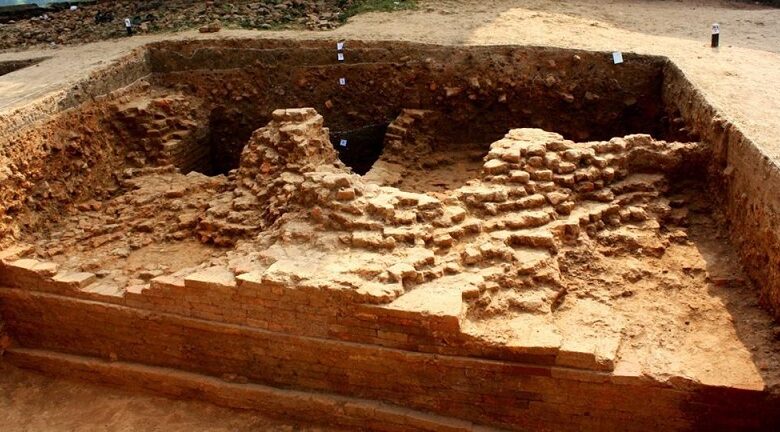Digging Into Bengal’s Bharatpur Reveal A Buddhist Monastery Structure

A Buddhist monastery was found during recent excavations at Bharatpur in the Paschim Bardhaman region of West Bengal. Since the second week of January, when the Kolkata Circle of the Archeological Survey of India (ASI) began excavating the site, a monastery’s structural complex has been partially revealed.
Archaeologists from ASI and Burdwan University discovered a Buddhist stupa at the site in 1972, leading to the site’s initial excavation between 1972 and 1975, which took place approximately fifty years ago.
The archaeologists at Bharatpur will be able to learn more information about the monastery complex and its construction date as the dig moves on, according to Mr. Majumder, who is overseeing the excavations.
Unique stupa
Experts claim that the site’s inclusion of a sizable stupa, a monastery complex, and black and red ware pottery from the Chalcolithic or Copper Age sets it apart from other Buddhist sites in the State. Archaeologists have only discovered smaller votive stupas at other West Bengali sites like Karnasubarna in Murshidabad, Moghalamari in Paschim Medinipur, and Jagjivanpur in Malda.
A votive stupa is a smaller construction that originates in eight cylindrical forms, whereas a Buddhist stupa is a memorial monument that typically houses holy relics connected to the Buddha or other saints or priests.
Archaeologists discovered black and red ware pottery at the site during the 1970s excavations, which is associated with the Chalcolithic Age and predates any Buddhist constructions.
Village settlements from the past
The site is significant for two main reasons, according to Rupendra Kumar Chattopadhyay, a former professor at the Department of Archeology, University of Calcutta: first, because it is an early village settlement on the bank of the river Damodar that may date to around 2000 BCE; and second, because it is a Buddhist monastery complex.
According to Professor Chattopadhyay, the location may have served as the hub of an early village farming community from which sites spread out to other regions along the Damodar River’s other side and to other rivers including the Ajoy and the Darakeshwar.
According to Mr. Majumder, there are other prehistoric sites in the area, including early village farming sites at Dihar and Pakhanna on the other bank of the Damodar in the State’s Bankura district. He continued by saying that the excavation is an effort to track the cultural continuity of the area, where villages may have existed for a very long time.
Sculptures discovered
Five exquisite statues of the Buddha seated in the Bhumisparsha Mudra, with all five fingers of the right hand outstretched to touch the ground, were discovered during the site’s excavation in the 1970s, along with the stupa. Each of these 30 cm tall small statues was probably utilized in the monastery’s liturgy.
Both Dr. Majumder and Professor Chattopadhyay stated that practically all of the Buddhist sites have been discovered in the Rarh Bengal region, which is located in the State’s southwest. The ongoing excavation at Bharatpur, which is located in the same area, may provide intriguing details regarding the spread of Buddhism there, the author stated.
News Mania Desk






